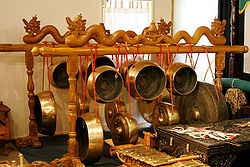
The
gong ageng (
Kromo JavaneseJavanese language is the language of the people in the central and eastern parts of the island of Java, in Indonesia. In addition, there are also some pockets of Javanese speakers in the northern coast of western Java...
meaning large gong, ngoko is
gong gedhe) is the largest
gongA gong is an East and South East Asian musical instrument that takes the form of a flat metal disc which is hit with a mallet.Gongs are broadly of three types. Suspended gongs are more or less flat, circular discs of metal suspended vertically by means of a cord passed through holes near to the top...
in a Javanese and Balinese
gamelanA gamelan is a musical ensemble from Indonesia, typically from the islands of Bali or Java, featuring a variety of instruments such as metallophones, xylophones, drums and gongs; bamboo flutes, bowed and plucked strings. Vocalists may also be included....
. It is used as to mark the largest phrases in the structure. In small structures, the gong ageng is used to mark larger groups than the smaller gong suwukan. In the larger
gendhingThe gendhing is a class of gendhing structures used in Javanese gamelan music. Gendhing can also used to refer to gamelan compositions in general....
, only the gong ageng is used. It is typically pitched to match the 6 of the gamelan. Full gamelans sometimes only have one, for both
pélogPelog is one of the two essential scales of gamelan music native to Bali and Java, in Indonesia. The other scale commonly used is called slendro. Pelog has seven notes, but many gamelan ensembles only have keys for five of the pitches...
and
sléndroSlendro is a pentatonic scale, one of the two most common scales used in Indonesian gamelan music, the other being pélog.-Tuning:...
, but can have both as well, even if the pitches are the same.
The
gong suwukan or
gong siyem is the smaller gong in the set used for smaller phrases. It is generally pitched higher, and at different pitches for pélog and sléndro. Frequently gamelans will have more than one gong suwukan, for different ending notes, and different
pathetThe pathet is an organizing concept in gamelan music. It is difficult to explain, but is similar to the melody types, that is, for example, modes, ragas, or maqamat, of other musics....
. Most common is a 1 for pathet sanga and lima, and 2 for pélog pathet nem and barang, and sléndro pathet nem and manyura. Usually a 1 can be played for
gatraA gatra is a unit of melody in Javanese gamelan music, analogous to a measure in Western music. It is often considered the smallest unit of a gamelan composition....
ending in 1 or 5, and a 2 for 2 or 6. A few gamelans include a gong suwukan 3 as well.
A
gongan is the time between soundings of the gong which can vary from a few seconds to several minutes depending on the
tempoIn musical terminology, tempo is the speed or pace of a given piece. It is a crucial element of composition, as it can affect the mood and difficulty of a piece.-Measuring tempo:...
,
iramaIrama is a concept used in Javanese gamelan music, which relates to how much space there is between notes. It is often confused with tempo, although tempo is different, and each irama can be played in different tempi....
, and length of the structure (bentuk). It is the longest time-span in the colotomic structure of gamelan. The
goong ageung plays a similar role in Sundanese gamelan (e.g. degung). The
kempur in Balinese gamelan is similar to the gong suwukan (and not to be confused with the Javanese
kempul In other Indonesian and Philippine cultures, its analog is the
agungThe agung is a set of two wide-rimmed, vertically-suspended gongs used by the Maguindanao, Maranao and Tausug people of the Philippines as a supportive instrument in kulintang ensembles...
.






This isn't bad, maybe some more relating to the article about the gong ageng.
ReplyDelete